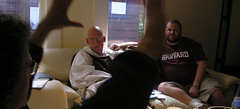A Brief History of Participation
For all that we speak of Web 2.0, peer-to-peer dynamics, and interactive everything, the nature of participation remains quite elusive. Indeed, even its basic timeline remains shrouded in mystery, for instance, the origins of the participatory map.
One author presents an origin story of participatory mapmaking
that begins with participant research methods invented by anthropologists in
response to postcolonial movements during the 1970s, and the first maps were
invented by Herlily in the 1990s. Another emphasize the role of the internet in interactive
maps tend to date a participatory mapping revolution to the advent of the
"mashup" in 2004, associated with the O'Reilly Media Web 2.0 conference in that year, and nearly simultaneous
appearance of Open Street Map (2004) and Google Maps (2005) soon thereafter.
In fact, the
idea of participatory governance has its origins long before the internet. Experiments with decentralized governance extend backwards
over the twentieth century, and indeed crowd sourced mapping appeared first in
the early 1970s. Indeed, since the
1980s, political theorists have urged the adoption of participatory measures
and succeeded in legislating the adoptation of participatory organization since
the 1990s. The current boom in crowd
sourced maps, characterized by startups and NGO activity around the Ushahidi
and Taarifa platforms, rides atop a far longer movement invested in seeing
participatory mechanisms transforming the state. In that climate, the arrival of mashed-up
maps in 2004 was looked to to cure a host of ills, including government
corruption, homelessness, famine, and water shortage.
This story is
strewn with the wreckage of technologies for participation past. Many are the mapping projects that sent
faciliators and programmers to the developing world, produced a trial run
showing where a few toilets should be located, then called the program off. They
include a history of legislation without mandate and maps in the service of
price sensitivity or other data collection on behalf of elites. All of them, originally, made similar claims
-- to create a more informed citizenry, to free expertise from the constraints
of disciplinary prejudice, to incorporate the poor and disenfranchised in the
political process, and to thereby enliven society.
Remembering
the long trajectory of this process is important to discerning the difference
between the hopeless reiteration of bad methods past and radical tools for
transforming society.
The roots of
suspicion towards centralized government are long. The early medieval church's policy of
subsidiary, or putting culturally-inflected decisions in the hands of the local
bishop rather than the papacy. Criticism
of centralized bureaucracies typical of the modern nation-state is at least as
old as the centralized state itself. In
the 1830s and 40s in Britain, a mere generation after that nation saw the
appearance of the first modern Post Office and Highway system, a
counter-movement appeared calling for a revivification of decentralized
government. Authors like Joshua Toulmin Smith called for a localist uprising against the centralized
bureaucrats, questioning the nature of civil engineers' claims to authority,
and extolling the virtues of face-to-face government in the traditional parish.
In
the late nineteenth century, the expansion of the vote and mass education
generated many questions about how the knowledge of the many could find its way
to the organs of administration. In Britain, for instance, the
advent of the vote for working people (1867 and 1883) and mass compulsory
education (1880) was accompanied by the rise of populist politics that insisted
on the creation of socialist measures like land reform and health insurance
designed to distribute the benefits of industrialization to all the nation's
citizens
Self-rule
had been theorized by anarchists and syndicalists like Peter Kropotkin, who
recognized in the working men's unions of Switzerland a resilient form of local
politics characterized by the active equality of all its members. In Mutual
Aid (1902), Kropotkin urged a vision of decentralized, small-scale economic
production coordinated by local political bodies. In Words of a Rebel (1904), he
denounced banks and the civil service as
a parasitic form of centralized authority that prohibited peasants from
realizing their full political potential.
"The
taxes that crush you are devoured by bands of bureaucrats who are not merely
useless but positively harmful," he clamored. "Therefore we must suppress
them." He urged his readers,
"Proclaim your absolute independence, and declare that you know better how
to manage your affairs than these gentlemen in gloves from Paris." Kropotkins denunciation of bureaucracy and his praise of local knowledge
was mirrored later by many intellectuals on both the right and the left,
reappearing in postcolonial contexts to condemn the exploitation of authority
by empire. The positive aspect of
Kropotkin's vision, however, consisted in observations about the power of local
community to come up with solutions that expanded upon the potential of all of
society'e members. The vision was
embraced by Patrick Geddes, who encountered Kropotkin during the latter's stay
in London.
By
the 1960s, these precedents for retooled governance, influenced a body of thought rethinking
governance assimilated into a holistic political theory of self-rule applicable
to urban planning and the administration of everyday life. Driven by mass youth movements,
enormous gatherings in public, the dissemination of ideas through mass media,
and contentious political ideas around civil society in an era of racial
integration, a new theory of "democratic participation" drew out old
ideas about decentralized governance into a renewed vision of democracy. A participatory democracy was one in which the
many would have a voice. it would depend
upon inclusive definitions of citizenship and a commitment to decentralized
self-governance.
Through
the action of new institutions like the World Bank, the developing world became
a laboratory for these participatory methods. In
the young discipline of development economics, open-minded scholars adopted the
1960s' theories about political life, reinterpreting them into a call for newly
nationalized former colonies to include their poorest citizens in the production
of a truly democratic state. At the University of Sussex,
economist Dudley Seers argued that the practice of foreign aid, with its
traditional linkage to charity and to the corporations favored by western
empires, did little to build up local industries at home. Seers'
complaints echoed those of Gandhi and Gandhi-influenced economists in India,
who complained that British industries had drained resources from the country
without building up a resilient economy that enriched the poor. Beginning
in the 1970s, another member of the Sussex faculty, Robert Chambers, began to
develop techniques for creating a crowdsourced map. The
crowdsourced map was thereafter used to protect territories by indigenous
people from logging
Participatory
maps thereafter had a long and complicated trajectory. Chambers
was sought out in the 1980s and 90s by Indian students who saw in his methods
the possibility of retailoring Indian democracy in the shape of participation. Chamber's
student Neela Mukherjee became a consultant for the World Bank, working first
in Thailand and the Philippines on plans to help poor farmers come to their own
discernment about which crops to plant and when. Eventually, Mukherjee returned to India and
began training students in the principles of making participatory maps and
authored a textbook called Participatory Methods. Chapter 5 on walking foregrounds walking territory as a key
to participatory learning about farming, local plants, local history and
infrastructure for farmers in the developing world seeking greater control over
their own land and especially food sovereignty. In the 1990s, a team of American geographers centered on
the University of West Virginia used GIS and mental mapping to facilitate
community conversations about equitable land decisions, land access to water,
and ethnic memory of customary land rights in post-apartheid South Africa.
The
theme of participatory ownership of the city, pioneered in discussions about
urban planning in the West, remained strong in the context of the developing
world, and even grew in a context of spiraling urbanization. In
India, the Philippines, and much of Africa and Latin America, postwar economies
pushed peasants off of the land into cities, where the poor availability of
housing required the poor to squat on land and build their own homes out of
cheap building materials.
At
first, the governments of these towns collaborated with the World Bank to take
out loans to provide expensive, high-rise public housing units. But increasingly, the World Bank drew upon
the advice of western advocates of squatter settlements, who saw in western
squats the potential benefits of self-governance without interference from the
state. In the hands of the World Bank,
this theory of self-directed, self-built, self-governed housing projects became
a justification for defunding public housing.
From 1972 forward, World Bank reports commended squatters for their
ingenuity and resourcefulness and recommended giving squatters titles to their
properties, which would allow them to raise credit and participate in the
economy as consumers and borrowers.
These
activities were not always congenial to the program of government reform
towards democratization. Many of them
used participatory methods instead to net poor peoples into networks of debt
and reliance on hierarchical authorities.
The reasons for the failures of participatory technology are actually quite specific.
Participation was appropriated during the 1970s as a means of cheap development without commitment of resources from above. The theme of participatory ownership of the city, pioneered in discussions about urban planning in the West, remained strong in the context of the developing world, and even grew in a context of spiraling urbanization. In India, the Philippines, and much of Africa and Latin America, postwar economies pushed peasants off of the land into cities, where the poor availability of housing required the poor to squat on land and build their own homes out of cheap building materials. At first, the governments of these towns collaborated with the World Bank to take out loans to provide expensive, high-rise public housing units. But increasingly, the World Bank drew upon the advice of western advocates of squatter settlements, who saw in western squats the potential benefits of self-governance without interference from the state. In the hands of the World Bank, this theory of self-directed, self-built, self-governed housing projects became a justification for defunding public housing. From 1972 forward, World Bank reports commended squatters for their ingenuity and resourcefulness and recommended giving squatters titles to their properties, which would allow them to raise credit and participate in the economy as consumers and borrowers.
Participatory mechanisms installed by the Indian government to deal with water tanks after nationalization depend on principles of accountability at the local level that were invented under colonial rule. They install the duty of the locality to take care of people without necessarily providing the means with which to do so.
We need developers who can learn from the history of futility, and historians who have the courage to constructively encourage a more informed kind of development.










0 Comments:
Post a Comment
<< Home